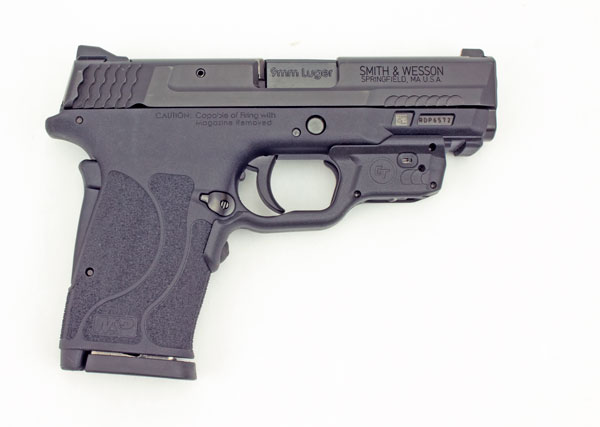A value proposition caused me to buy my first Taurus semi-automatic pistol, a 9mm PT 24/7 Pro. That was at least fifteen years ago. Sometime thereafter I bought one in .40 S&W, and later I picked up a .45ACP PT 24/7 Pro DS. These guns have always been among my favorites. I’ve watched the YouTube videos and read the rants on forums about problems and issues with these earlier semi-automatics while mine have continued to perform flawlessly. There was a recall and a settlement of a class action lawsuit regarding the PT-111 Millennium. With that all in the past, I’ve been comfortable for years recommending the Taurus Millennium series as a carry gun to budget-minded customers.
Current reports from wholesalers and Gunbroker indicate the Millennium G2 is one of the top selling concealed carry handguns. That makes sense as it typically sells for around $200 and is very close in size to the popular single stack nines that hold six or seven rounds and cost more than twice as much. The G2’s capacity is 13 rounds. Even though I own more expensive guns in brands that everyone stands up and applauds, I keep a G2 handy in a Nate Squared IWB holster for whenever I have reason to leave the house on short notice. I know some of you reading this have concerns about Taurus quality due to publicity and recalls, but I personally have been a heavy and consistent Taurus user for years and haven’t experienced any of the reported problems, nor have any of my customers. Taurus has faced those earlier problems and apparently fixed them. They also offer a lifetime guarantee on their firearms.
Now Taurus has released an upgraded, larger version of the Millennium G2, calling it simply the G3. Before my pre-release evaluation copy of the G3 arrived, I found myself hoping it would be a 9mm version of the Taurus TX22. I recently reviewed the TX22 and called it a .22 in 9mm clothing. The G3 is not configured like the TX22 and I think the Taurus engineers missed an opportunity there. But it’s close and they did what they set out to do—make a G2 big brother.

The G3 has a lot to offer, starting with the grip. Aggressively stippled grip patches on the side panels, the front strap and the back strap provide a no-slip grip that does not become uncomfortable during extended shooting sessions. The stippling is little bit finer, more sandpapery, than what’s on the G2. Further defining ergonomics of the grip is a palm swell located high on the backstrap. The palm swell, along with thumb shelves on either side of the frame, help the shooter obtain a fast, secure grip that orients the muzzle. The combination makes the G3 a natural pointing machine. Integrated into the frame above the trigger are what Taurus calls Taurus Memory Pads, which are small recesses that offer a natural location for indexing of the trigger finger when not actively engaging the target. The thumb shelves and memory pads are on both sides of the frame to accommodate left- and right-hand shooters. These features are carryovers from the Taurus PT 24/7 Pro.

A version of the PT 24/7 dubbed OSS was designed as an entrant when The United States Special Operations Command (USSOCOM) issued requirements in 2005 for a new .45 ACP service pistol. That USSOCOM request was at first delayed, later cancelled, leaving Taurus with an excellent candidate for the concealed carry market. Not long after I bought my first one, a friend who is a Texas State Trooper told me the Texas Department of Public Safety had seriously considered the Taurus PT 24/7 before the decision was made to outfit the troopers with Sig Sauer P226s in .357 Sig. Many of the troopers preferred the Taurus, but politics apparently intervened.
The lineup at Taurus changes from year to year. The PT 24/7 pistols were in the 2017 lineup but dropped for 2018. It’s refreshing to see a full-size, striker-fired Taurus back on the market with the G3. The MSRP is $345.23 in all black and $360.70 with a stainless-steel slide, which will translate to around $300–$325 at gun stores when the guns are readily available. Taurus wanted to give its customers a lot of gun for that $300–$350 price tag and it appears they did just that.
The G3 weighs 25 oz. and has a 4″ barrel. The pre-release gun I received for evaluation has one 15-round magazine and one extended 17-round magazine. The slide is rounded and tapered in the front making it easy to holster and snag free around clothing. It has standard 3-dot white sights, which are a little smaller than on my G2, making them harder for these old eyes to see. The rear sight is adjustable. Mildly cut serrations front and rear make slide operation easy and the Picatinny rail for lights and lasers is present. A small viewport at the back of the chamber serves as an indicator to see if the gun is loaded.
The G3’s trigger is much improved over earlier Taurus pistols. I measured it at a consistent 6 lbs. Once a cartridge is chambered, the G3 utilizes a single-action firing system. A feature you’ll only find on Taurus handguns as far as I am aware is the second-strike capability. In the event of a failure-to-fire, you can reset and pull the trigger again to restrike the primer. You can do it again and again and again if you want to, but of course somewhere along the line you should probably stop and get a new cartridge in the chamber.

Since the G3 is both a new gun and an evolution of other Taurus products, I decided having some of those other products at the range for some comparison shooting would be a good idea. I took a 9mm G2, a .45ACP 24/7 Pro DS and the .22 Caliber TX22. I started the session by shooting the TX22 which is a delight to shoot and closely matches the ergonomics of the G3 test pistol. Then I shot a few groups with the G2. They were tight and set the bar. The 24/7 has great sights, a smooth trigger and ergonomics very close to those of the G3. But I didn’t shoot it much because it’s a .45, and for some reason I was a little extra sensitive to recoil that day.
I had several brands of 9mm ammo on hand and expected to shoot the G3 for a while before settling down and concentrating on getting a nice grouping for a photo. But I was in for a surprise. The first ten rounds I fired was from an old box of Winchester White Box FMJ and darned if they didn’t produce a group I figured would be hard to beat. I marked that one for my target photo, but as I continued shooting at other targets with various types of ammo, any one of several resulting targets could have been used to show off the G3’s accuracy. Naturally I had some flyers, but whenever I settled down on the sights and operated the trigger correctly, the G3 sent the rounds straight and true.

Let’s be honest. Not everybody has a six-figure income. For many of us, a $300–$350 gun that carries well, shoots well and has a lifetime warranty is exactly what we need for self-defense. It’s a good gun to use when introducing a friend or family member to the shooting fraternity. It can be an addition to any gun collection with a non-painful acquisition cost. And just wait. I bet Team Taurus will make owners of this gun proud by making it a winner in competition.







